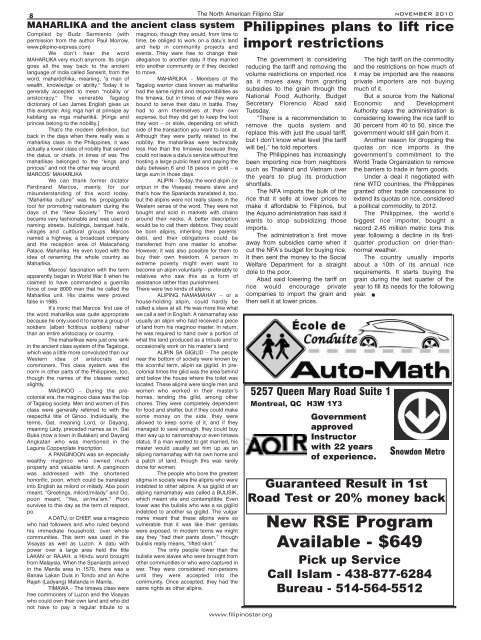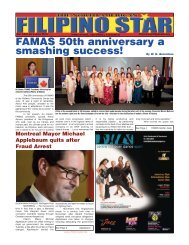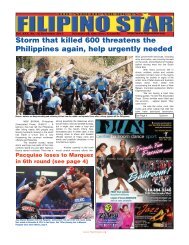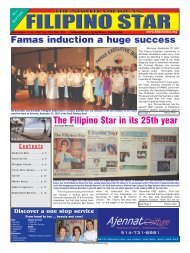Filipino Star - November 2010 Issue
Filipino Star - November 2010 Issue
Filipino Star - November 2010 Issue
You also want an ePaper? Increase the reach of your titles
YUMPU automatically turns print PDFs into web optimized ePapers that Google loves.
8<br />
MAHARLIKA and the ancient class system<br />
Compiled by Budz Sarmiento (with<br />
permission from the author Paul Morrow,<br />
www.pilipino-express.com)<br />
We don’t hear the word<br />
MAHARLIKA very much anymore. Its origin<br />
goes all the way back to the ancient<br />
language of India called Sanskrit, from the<br />
word, maharddhika, meaning, "a man of<br />
wealth, knowledge or ability." Today it is<br />
generally accepted to mean "nobility or<br />
aristocracy." The venerable Tagalog<br />
dictionary of Leo James English gives us<br />
this example: Ang mga harì at prinsipe ay<br />
kabilang sa mga maharlikâ. [Kings and<br />
princes belong to the nobility.]<br />
That’s the modern definition, but<br />
back in the days when there really was a<br />
maharlika class in the Philippines, it was<br />
actually a lower class of nobility that served<br />
the datus, or chiefs, in times of war. The<br />
maharlikas belonged to the “kings and<br />
princes” and not the other way around.<br />
MARCOS’ MAHARLIKA<br />
We can thank former dictator<br />
Ferdinand Marcos, mainly, for our<br />
misunderstanding of this word today.<br />
“Maharlika culture” was his propaganda<br />
tool for promoting nationalism during the<br />
days of the “New Society.” The word<br />
became very fashionable and was used in<br />
naming streets, buildings, banquet halls,<br />
villages and cult0ural groups. Marcos<br />
named a highway, a broadcast company<br />
and the reception area of Malacañang<br />
Palace, Maharlika. He even toyed with the<br />
idea of renaming the whole country as<br />
Maharlika.<br />
Marcos’ fascination with the term<br />
apparently began in World War II when he<br />
claimed to have commanded a guerrilla<br />
force of over 8000 men that he called the<br />
Maharlika unit. His claims were proved<br />
false in 1985.<br />
It’s ironic that Marcos’ first use of<br />
the word maharlika was quite appropriate<br />
because he only used it to name a group of<br />
soldiers (albeit fictitious soldiers) rather<br />
than an entire aristocracy or country.<br />
The maharlikas were just one rank<br />
in the ancient class system of the Tagalogs,<br />
which was a little more convoluted than our<br />
Western idea of aristocrats and<br />
commoners. This class system was the<br />
norm in other parts of the Philippines, too,<br />
though the names of the classes varied<br />
slightly.<br />
MAGINOO – During the precolonial<br />
era, the maginoo class was the top<br />
of Tagalog society. Men and women of this<br />
class were generally referred to with the<br />
respectful title of Ginoo. Individually, the<br />
terms, Gat, meaning Lord, or Dayang,<br />
meaning Lady, preceded names as in, Gat<br />
Buka (now a town in Bulakan) and Dayang<br />
Angkatan who was mentioned in the<br />
Laguna Copperplate Inscription.<br />
A PANGINOON was an especially<br />
wealthy maginoo who owned much<br />
property and valuable land. A panginoon<br />
was addressed with the shortened<br />
honorific, poon, which could be translated<br />
into English as milord or milady. Aba poon<br />
meant, “Greetings, milord/milady” and Oo,<br />
poon meant, “Yes, sir/ma’am.” Poon<br />
survives to this day as the term of respect,<br />
po.<br />
A DATU, or CHIEF, was a maginoo<br />
who had followers and who ruled beyond<br />
his immediate household, over whole<br />
communities. This term was used in the<br />
Visayas as well as Luzon. A datu with<br />
power over a large area held the title<br />
LAKAN or RAJAH, a Hindu word brought<br />
from Malaysia. When the Spaniards arrived<br />
in the Manila area in 1570, there was a<br />
Banaw Lakan Dula in Tondo and an Ache<br />
Rajah (Ladyang) Matanda in Manila.<br />
TIMAWA – The timawa class were<br />
free commoners of Luzon and the Visayas<br />
who could own their own land and who did<br />
not have to pay a regular tribute to a<br />
maginoo, though they would, from time to<br />
time, be obliged to work on a datu’s land<br />
and help in community projects and<br />
events. They were free to change their<br />
allegiance to another datu if they married<br />
into another community or if they decided<br />
to move.<br />
MAHARLIKA – Members of the<br />
Tagalog warrior class known as maharlika<br />
had the same rights and responsibilities as<br />
the timawa, but in times of war they were<br />
bound to serve their datu in battle. They<br />
had to arm themselves at their own<br />
expense, but they did get to keep the loot<br />
they won – or stole, depending on which<br />
side of the transaction you want to look at.<br />
Although they were partly related to the<br />
nobility, the maharlikas were technically<br />
less free than the timawas because they<br />
could not leave a datu’s service without first<br />
hosting a large public feast and paying the<br />
datu between 6 and 18 pesos in gold – a<br />
large sum in those days.<br />
ALIPIN – Today, the word alipin (or<br />
oripun in the Visayas) means slave and<br />
that’s how the Spaniards translated it, too,<br />
but the alipins were not really slaves in the<br />
Western sense of the word. They were not<br />
bought and sold in markets with chains<br />
around their necks. A better description<br />
would be to call them debtors. They could<br />
be born alipins, inheriting their parents’<br />
debt, and their obligations could be<br />
transferred from one master to another.<br />
However, it was also possible for them to<br />
buy their own freedom. A person in<br />
extreme poverty might even want to<br />
become an alipin voluntarily – preferably to<br />
relatives who saw this as a form of<br />
assistance rather than punishment.<br />
There were two kinds of alipins:<br />
ALIPING NAMAMAHAY – or a<br />
house-holding alipin, could hardly be<br />
called a slave at all. He was more like what<br />
we call a serf in English. A namamahay was<br />
usually an alipin who had received a piece<br />
of land from his maginoo master. In return,<br />
he was required to hand over a portion of<br />
what the land produced as a tribute and to<br />
occasionally work on his master’s land.<br />
ALIPIN SA GIGILID – The people<br />
near the bottom of society were known by<br />
the scornful term, alipin sa gigilid. In precolonial<br />
times the gilid was the area behind<br />
and below the house where the toilet was<br />
located. These alipins were single men and<br />
women who worked in their master’s<br />
homes, tending the gilid, among other<br />
chores. They were completely dependent<br />
for food and shelter, but if they could make<br />
some money on the side, they were<br />
allowed to keep some of it, and if they<br />
managed to save enough, they could buy<br />
their way up to namamahay or even timawa<br />
status. If a man wanted to get married, his<br />
master would usually set him up as an<br />
aliping namamahay with his own home and<br />
a patch of land, though this was rarely<br />
done for women.<br />
The people who bore the greatest<br />
stigma in society were the alipins who were<br />
indebted to other alipins. A sa gigilid of an<br />
aliping namamahay was called a BULISIK,<br />
which meant vile and contemptible. Even<br />
lower was the bulislis who was a sa gigilid<br />
indebted to another sa gigilid. The vulgar<br />
name meant that these alipins were so<br />
vulnerable that it was like their genitals<br />
were exposed. In modern terms we might<br />
say they “had their pants down,” though<br />
bulislis really means, “lifted skirt.”<br />
The only people lower than the<br />
bulislis were slaves who were brought from<br />
other communities or who were captured in<br />
war. They were considered non-persons<br />
until they were accepted into the<br />
community. Once accepted, they had the<br />
same rights as other alipins.<br />
The North American <strong>Filipino</strong> <strong>Star</strong><br />
www.filipinostar.org<br />
5257 Queen Mary Road Suite 1<br />
Montreal, QC H3W 1Y3<br />
nOVEMBER <strong>2010</strong><br />
Philippines plans to lift rice<br />
import restrictions<br />
The government is considering<br />
reducing the tariff and removing the<br />
volume restrictions on imported rice<br />
as it moves away from granting<br />
subsidies to the grain through the<br />
National Food Authority, Budget<br />
Secretary Florencio Abad said<br />
Tuesday.<br />
“There is a recommendation to<br />
remove the quota system and<br />
replace this with just the usual tariff,<br />
but I don’t know what level [the tariff<br />
will be],” he told reporters.<br />
The Philippines has increasingly<br />
been importing rice from neighbors<br />
such as Thailand and Vietnam over<br />
the years to plug its production<br />
shortfalls.<br />
The NFA imports the bulk of the<br />
rice that it sells at lower prices to<br />
make it affordable to <strong>Filipino</strong>s, but<br />
the Aquino administration has said it<br />
wants to stop subsidizing those<br />
imports.<br />
The administration’s first move<br />
away from subsidies came when it<br />
cut the NFA’s budget for buying rice.<br />
It then sent the money to the Social<br />
Welfare Department for a straight<br />
dole to the poor.<br />
Abad said lowering the tariff on<br />
rice would encourage private<br />
companies to import the grain and<br />
then sell it at lower prices.<br />
Government<br />
approved<br />
Instructor<br />
with 22 years<br />
of experience.<br />
The high tariff on the commodity<br />
and the restrictions on how much of<br />
it may be imported are the reasons<br />
private importers are not buying<br />
much of it.<br />
But a source from the National<br />
Economic and Development<br />
Authority says the administration is<br />
considering lowering the rice tariff to<br />
30 percent from 40 to 50, since the<br />
government would still gain from it.<br />
Another reason for dropping the<br />
quotas on rice imports is the<br />
government’s commitment to the<br />
World Trade Organization to remove<br />
the barriers to trade in farm goods.<br />
Under a deal it negotiated with<br />
nine WTO countries, the Philippines<br />
granted other trade concessions to<br />
extend its quotas on rice, considered<br />
a political commodity, to 2012.<br />
The Philippines, the world’s<br />
biggest rice importer, bought a<br />
record 2.45 million metric tons this<br />
year following a decline in its firstquarter<br />
production on drier-thannormal<br />
weather.<br />
The country usually imports<br />
about a 10th of its annual rice<br />
requirements. It starts buying the<br />
grain during the last quarter of the<br />
year to fill its needs for the following<br />
year. a<br />
Snowdon Metro<br />
Guaranteed Result in 1st<br />
Road Test or 20% money back<br />
New RSE Program<br />
Available - $649<br />
Pick up Service<br />
Call Islam - 438-877-6284<br />
Bureau - 514-564-5512















